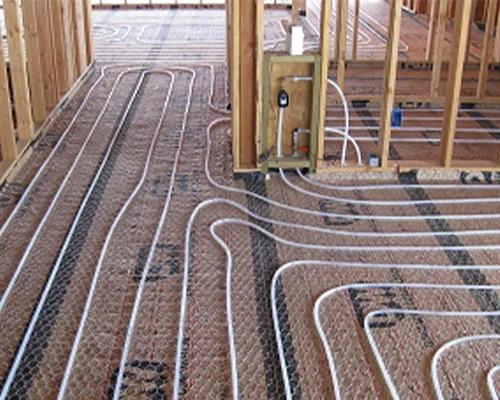Top 5 Factors That Impact Radiant Floor Heating System Cost in New Construction

Installing radiant heating during new construction is a smart way to future-proof your home. But before you move ahead, it’s important to understand what affects the total radiant floor heating system cost. Every design choice—from flooring material to zoning complexity—can influence how much you’ll spend.
Let’s break down the top five factors that determine cost when installing hydronic in-floor radiant heating in new homes.
1. Flooring Type and How It Affects Installation
Your flooring material plays a major role in both performance and cost.
● Tile and stone conduct heat efficiently. Installation is straightforward with tubing embedded in thinset or slab.
● Engineered wood can work well, but might require an extra underlayment for protection against heat expansion.
● Vinyl and laminate need radiant-compatible products and a level subfloor—both of which add to material and labor costs.
● Carpet insulates too much and requires higher water temperatures, which drives up energy use.
The easier it is to install radiant heating under your chosen floor, the lower your labor and material costs will be.
2. Size of Heated Area and Zoning Layout
Larger areas mean more pipe, more controls, and more time.
● A single small zone, like a bathroom or mudroom, is quick and cost-effective.
● Open-plan living spaces, basements, or entire main floors raise system costs due to increased tubing, insulation, and setup time.
● More hydronic in-floor radiant heating zones mean more manifolds, sensors, and thermostats.
Each new zone adds cost, but also allows personalized comfort and improved energy control.
3. Insulation and Subfloor Prep Work
Proper insulation under the tubing is essential to prevent heat loss and increase system efficiency.
● Rigid foam boards under concrete slabs add insulation and material cost.
● Slab leveling compounds are needed for uneven floors and may require added labor.
● Subfloor systems with plywood or pre-fabricated panels provide insulation but increase the radiant floor heating system cost.
Cutting corners on insulation might reduce upfront cost, but it leads to higher operating expenses down the line.
4. Boiler, Pump, and Control System Choices
The mechanical parts of your system can make or break your budget and your comfort.
● Condensing boilers are more efficient but come with a higher upfront cost.
● Pump size, type, and brand all matter. More zones mean more circulators and valves.
● Digital thermostats and smart zoning controls allow fine-tuned heating, but also increase your setup cost.
Higher-end controls give you more comfort and energy savings, so it’s often worth the investment.
5. Labor, Design Complexity, and Warranty Considerations
You could buy the best components on the market, but if they’re installed poorly, the system won’t perform.
● Complex floor plans or unusual room shapes raise the cost of design and labor.
● More zones and levels in your home require more planning time.
● Regions with higher labor costs drive up installation expenses.
● Certified installers often charge more, but their systems come with extended warranties and meet strict standards.
Investing in quality design and professional labor reduces risk and increases long-term value.
Bonus Tip: Combine Design and Installation Services
Bundling zoning design, boiler sizing, and radiant layout with the same team can reduce project timelines and help avoid miscommunication.
● Fewer contractors = fewer delays
● Coordinated installation means smoother system performance
● Potential cost savings on scheduling and logistics
A coordinated approach also ensures the system works as a whole, not just a collection of parts.
Final Thoughts
Building a new home is the perfect opportunity to add a high-performance radiant system that will serve you for decades. But before you start, be aware of the five biggest cost drivers:
● Flooring material and installation type
● Area coverage and zoning design
● Insulation and subfloor prep
● Mechanical components like the boiler and the pump
● Labor rates and the complexity of your home layout
By understanding these factors, you can better plan your hydronic in-floor radiant heating system and avoid surprises down the road. A little upfront planning goes a long way toward creating a more efficient and comfortable home.








